
Dictyoptera is an insect superorder that includes two extant orders of polyneopterous insects: the order Blattodea and the order Mantodea (mantises). All modern Dictyoptera have short ovipositors and typically lay oothecae. The oldest fossils of Dictyoptera from the Late Carboniferous, referred to as "roachoids" have long ovipositors and did not lay oothecae. The oldest modern oothecae-laying dictyopterans date to the Late Triassic.
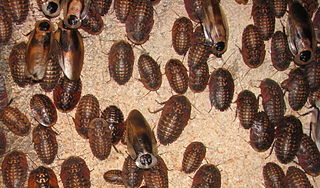
Giant cockroaches, or blaberids, are the second-largest cockroach family by number of species.

Ectobiidae is a family of the order Blattodea (cockroaches). This family contains many of the smaller common household pest cockroaches, among others. They are sometimes called wood cockroaches. A few notable species include:
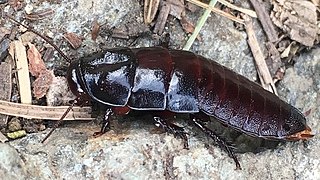
Cryptocercus is a genus of Dictyoptera and the sole member of its own family Cryptocercidae. Species are known as wood roaches or brown-hooded cockroaches. These roaches are subsocial, their young requiring considerable parental interaction. They also share wood-digesting gut bacteria types with wood-eating termites, and are therefore seen as evidence of a close genetic relationship, that termites are essentially evolved from social cockroaches.
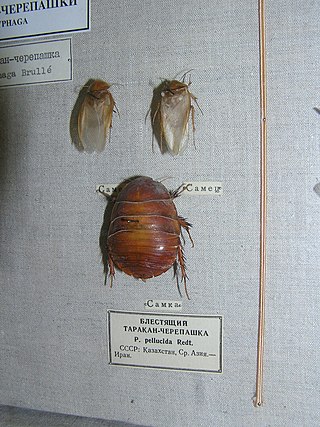
Corydiidae, previously known as Polyphagidae, is a family of the order Blattodea (cockroaches). Many are known as sand cockroaches. The family is divided into five subfamilies, comprising some 40 genera. One prominent species is the desert cockroach, Arenivaga investigata.

Blattodea is an order of insects that contains cockroaches and termites. Formerly, termites were considered a separate order, Isoptera, but genetic and molecular evidence suggests they evolved from within the cockroach lineage, cladistically making them cockroaches as well. The Blattodea and the mantis are now all considered part of the superorder Dictyoptera. Blattodea includes approximately 4,400 species of cockroach in almost 500 genera, and about 3,000 species of termite in around 300 genera.

Cockroaches are insects belonging to the order Blattaria. About 30 cockroach species out of 4,600 are associated with human habitats. Some species are well-known as pests.

Cimbicidae is a family of sawflies in the order Hymenoptera. There are more than 20 genera and 200 described species in Cimbicidae. Larvae are solitary herbivores.

Thaumatoneuridae is a family of damselflies in the order Odonata. There are at least three genera and about five described species in Thaumatoneuridae.

The Tryonicidae are a family of cockroaches.
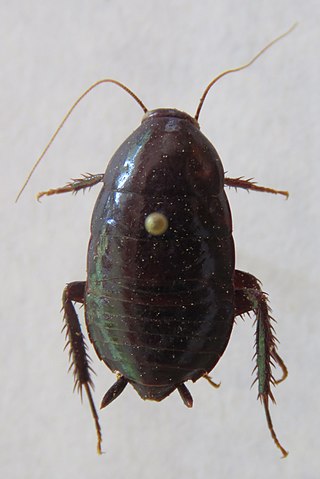
Lamproblattidae is a small family of South and Central American cockroaches in the order Blattodea. It consists of three genera and 10 species:

Corydioidea is a superfamily of insects in the order Blattodea, the cockroaches and termites. It contains two extant families, Corydiidae and Nocticolidae, comprising about fifty genera and two hundred and fifty species, along with the extinct family Liberiblattinidae. Members of this superfamily are found worldwide, mostly in hot, arid habitats.

Blattoidea is a superfamily of cockroaches and termites in the order Blattodea. There are about 17 families and more than 4,100 described species in Blattoidea.
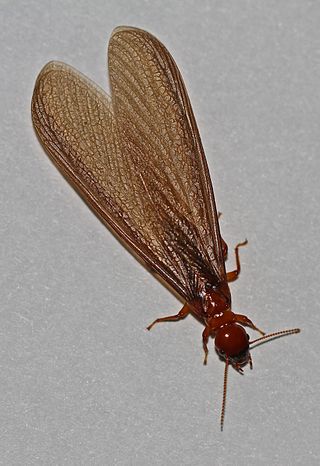
Archotermopsidae is a family of termites in the order Blattodea, known as dampwood termites, formerly included within the family Termopsidae. They constitute a small and rather primitive family with two extant genera and 5 living species. They may rarely infest structures but do not usually do so, nor do they cause extensive damage to buildings or other man-made structures unless said structure has been sufficiently damaged such as by water. As their name implies, they eat wood that is not dried out, perhaps even rotting, and consequently of little use to humans.

Stolotermitidae is a family of termites in the order Blattodea, with two extant genera formerly placed in the family Termopsidae. There are about 14 described species in Stolotermitidae.

Stylotermitidae is a family of termites in the order Blattodea. There are two extinct and one extant genera in Stylotermitidae, with more than 50 described species.

Megastigmidae is a family of chalcid wasps in the order Hymenoptera. There are about 12 genera and more than 170 described species in Megastigmidae. Megastigmidae was formerly considered a subfamily of the family Torymidae.

Philosinidae is a family of damselflies in the order Odonata. There are at least 2 genera and about 12 described species in Philosinidae, found mainly in southeast Asia.

Corydiinae is a subfamily of the order Blattodea (cockroaches). Many are known as sand cockroaches. The subfamily, comprising about 20 genera, contains half the genera in Corydiidae. One prominent species is the desert cockroach, Arenivaga investigata.


















